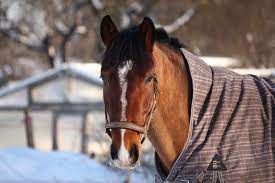Last Updated on August 21, 2023 by Allison Price
It’s that time again. Our concern for our horses’ well-being increases as the days get shorter and the weather gets colder. Is it possible for them to stay warm on their own? Do they need blankets? What kind of blankets do they need?
A recent study has shown that 50% of equestrians are not educated about their horses’ physiological reactions to temperature changes. This can pose a serious risk to an animal’s welfare. Sometimes, even the best intentions can lead to unintended consequences. On warm January days at the stable, I have removed heavy blankets from clients only to find a wet horse beneath. Clients never asked the barn staff to take care of their blanketing.
This is my guide to blanketing your horse (or not), based on years of research, consultation, observation, trial and error, and many years of experimentation.
1. Accept responsibility
Horse owners have additional responsibility by monitoring the weather and making blanketing changes or having them done. However, horses and environments are not all created equal. Most veterinarians agree that most healthy, unclipped horses with shelter access don’t require blanketing.
2. Learn how to properly blanket if you make the decision to do so.
2. Once you’ve decided to blanket your horse (or “rug”), it is important to take the time to understand the process. You can find a lot of reliable resources online to help you choose the right size rug and what rug to use in different weather conditions. You will be a hero to your horse if you make sure they have a good blanketing experience.
3. Proper fitting tips
A. A. My hand goes under the blanket. I run the blanket gently from the buckles to the withers of the horse, paying attention to any pressure points.
A properly adjusted blanket placed in front of the withers.
Badly fitted blanket that is too far back from the withers. This could lead to high pressure and soreness.
B. B. This is the version that I found most effective at holding the blanket in place.
Properly fastened leg straps, as seen from behind the horse.
Securely fasten leg straps using this method This is how your final result should look under your horse. When fastening, simply loop one strap through to the other.
Tip: To prevent your straps from sliding, wrap duct tape around adjustment buckles. This will protect your horse’s legs against the cold, sometimes irritating metal.
C. C. Drooping straps can cause injury to horses and blankets. Overly tight straps can cause rubbing and discomfort.
Adjust blanket straps to fit your horse’s hands.
Planning, common sense and knowledge are key ingredients to blanketing your horse during the winter.



